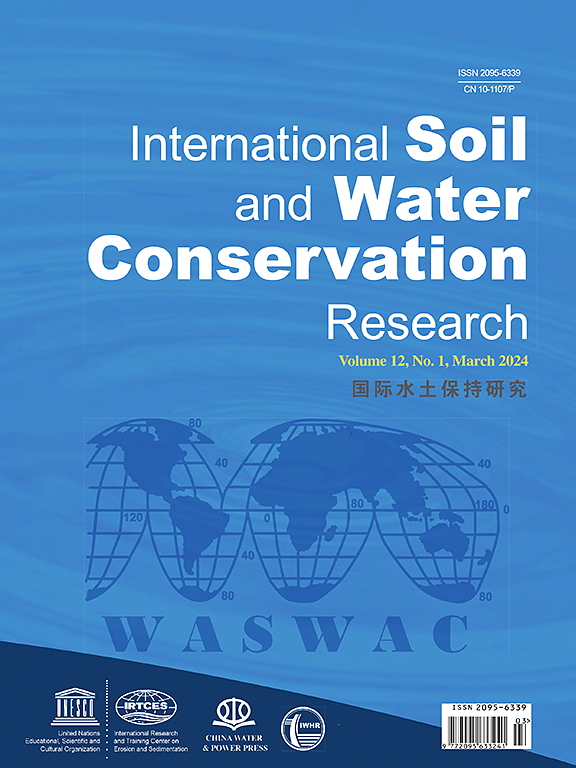Long-term effects of tillage practices and future climate scenarios on topsoil organic carbon stocks in Lower Austria – A modelling and long-term experiment study
IF 7.3
1区 农林科学
Q1 ENVIRONMENTAL SCIENCES
International Soil and Water Conservation Research
Pub Date : 2025-03-04
DOI:10.1016/j.iswcr.2025.02.011
引用次数: 0
Abstract
Conservation agriculture, with its reduced soil disturbance and enhanced cover, has the potential to increase carbon storage in the topsoil. However, it remains unclear how various tillage practices alter topsoil organic carbon (SOC) storage in the long-term affected by climate change. This study investigates the impacts of three tillage practices, Conventional Tillage (CT), Mulch Tillage (MT), and No-Till (NT) on future SOC stocks in the topsoil (0–15 cm), considering climate change scenarios (RCP4.5 and RCP8.5) and local soil erosion effects. Therefore, we calibrated and applied the integrated terrestrial C-N-P cycle model (N14CP) to a long-term study site with a cereal-maize dominant crop rotation in Lower Austria. Our calibration (1994–1995) resulted in a RMSE of 45.3 g m−2 and a PBIAS of 9.6%, while validation (2000–2023) resulted in a RMSE of 103.8 g m−2 and a PBIAS of 3.9%. Long-term simulations indicate that topsoil SOC stocks tend to increase under MT by +309 g m−2 (baseline), +233 g m−2 (RCP4.5), and +148 g m−2 (RCP8.5), under NT by +1145 g m−2 (baseline), +1059 g m−2 (RCP4.5), and +961 g m−2 (RPC8.5), but SOC stocks may decrease under CT by −209 g m−2 (baseline), −267 g m−2 (RCP4.5), and −332 g m−2 (RCP8.5) by 2100. In contrast to conventional management, our tested conservation agriculture practices (MT and NT) may both serve as viable options to mitigate climate change and erosion impacts on topsoil organic carbon in comparable agro-ecological settings.
耕作方式和未来气候情景对下奥地利州表层土壤有机碳储量的长期影响——一项模拟和长期试验研究
保护性农业减少了土壤干扰,增加了植被覆盖,具有增加表层土壤碳储量的潜力。然而,在气候变化的长期影响下,不同耕作方式如何改变表层土壤有机碳(SOC)储量仍不清楚。考虑气候变化情景(RCP4.5和RCP8.5)和局部土壤侵蚀效应,研究了常规耕作(CT)、覆盖耕作(MT)和免耕耕作(NT) 3种耕作方式对表层土壤(0-15 cm)未来有机碳储量的影响。因此,我们在下奥地利州一个以谷物-玉米为主要作物轮作的长期研究地点校准并应用了陆地碳氮磷综合循环模型(N14CP)。我们的校准(1994-1995)的RMSE为45.3 g m−2,PBIAS为9.6%,而验证(2000-2023)的RMSE为103.8 g m−2,PBIAS为3.9%。长期模拟表明,到2100年,土壤有机碳储量在旱作条件下增加+309 g m−2(基线)、+233 g m−2 (RCP4.5)和+148 g m−2 (RCP8.5),在旱作条件下增加+1145 g m−2(基线)、+1059 g m−2 (RCP4.5)和+961 g m−2 (RPC8.5),而在旱作条件下减少- 209 g m−2(基线)、- 267 g m−2 (RCP4.5)和- 332 g m−2 (RCP8.5)。与传统管理相比,我们经过测试的保护性农业实践(MT和NT)可以作为可行的选择,在可比的农业生态环境中减轻气候变化和侵蚀对表层土壤有机碳的影响。
本文章由计算机程序翻译,如有差异,请以英文原文为准。
求助全文
约1分钟内获得全文
求助全文
来源期刊

International Soil and Water Conservation Research
Agricultural and Biological Sciences-Agronomy and Crop Science
CiteScore
12.00
自引率
3.10%
发文量
171
审稿时长
49 days
期刊介绍:
The International Soil and Water Conservation Research (ISWCR), the official journal of World Association of Soil and Water Conservation (WASWAC) http://www.waswac.org, is a multidisciplinary journal of soil and water conservation research, practice, policy, and perspectives. It aims to disseminate new knowledge and promote the practice of soil and water conservation.
The scope of International Soil and Water Conservation Research includes research, strategies, and technologies for prediction, prevention, and protection of soil and water resources. It deals with identification, characterization, and modeling; dynamic monitoring and evaluation; assessment and management of conservation practice and creation and implementation of quality standards.
Examples of appropriate topical areas include (but are not limited to):
• Conservation models, tools, and technologies
• Conservation agricultural
• Soil health resources, indicators, assessment, and management
• Land degradation
• Sustainable development
• Soil erosion and its control
• Soil erosion processes
• Water resources assessment and management
• Watershed management
• Soil erosion models
• Literature review on topics related soil and water conservation research
 求助内容:
求助内容: 应助结果提醒方式:
应助结果提醒方式:


